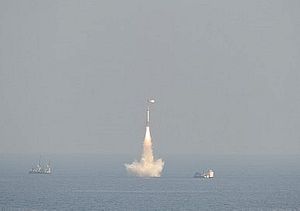India will test launch a K-4 intermediate-range nuclear-capable ballistic missile from a submerged pontoon platform in the Bay of Bengal at the end of the month, according to local media reports.
Although the missile has been designed to be fired from a depth of 50 meters, the January 31 test will see the K-4 launched from depths of 20-30 meters, an Indian defense official said. No further details were provided by the official.
The announcement of the K-4 trial launch follows Pakistan’s first-ever test of a nuclear-capable Babur-3 submarine-launched cruise missile (SLCM) in the Indian Ocean off the Pakistani coast in early January, and the successful launch of the surface-to-surface medium-range ballistic missile Ababeel, reportedly capable of carrying multiple warheads using Multiple Independent Re-entry Vehicle (MIRV) technology, on January 24 (See: “Pakistan Tests New Ballistic Missile Capable of Carrying Multiple Warheads”).
The K-4, developed by India’s Defense Research & Development Organization (DRDO), reportedly has a range of up to 3,500 kilometers (2,174 miles) and is capable of carrying a nuclear or conventional payload of more than 2,000 kilograms (4,400 pounds).
As I explained previously (See: “India to Test-Fire Secret Undersea Weapon”):
Technical details on the top-secret K-4 remain scarce. It purportedly is 12 meters (39 feet) long, weighs around 17 tons, can carry a nuclear capable warhead of up to 2 tons, and is powered by solid rocket propellants.
DRDO scientists claim that the missile is highly accurate with a near zero circular error probability. According to publicly available information, the K-4 uses a Ringer Laser Gyro Inertial navigation system.
The missile, capable of cruising at hypersonic speed, also features an “innovative” system of weaving in three dimensions during flight as it approaches its target.
India last tested the K-4 missile in April 2016 from aboard the country’s first domestically developed and built ballistic missile nuclear submarine (SSBN), the INS Arihant (quietly commissioned last October). (The sub’s four vertical launch tubes can be armed with up to four K-4 missiles.) Prior to April 2016, the missile was test launched from a submerged platform in March of the same year. According to DRDO scientists, the test was a “copy book success.”
The K-4 missile deployed aboard boats of the new Arihant-class will give the Indian Navy an undersea nuclear deterrent capability. However, “one of the major problems for India remains that its submarine force is too noisy, calling into question the credibility of its second-strike capability even with the new K-4 missile,” I explained elsewhere. India’s nuclear warfare policy is centered on a No First-Use (NFU) doctrine and New Delhi keeps nuclear warheads de-mated from missiles.
































